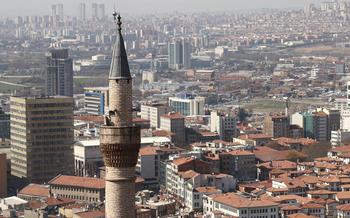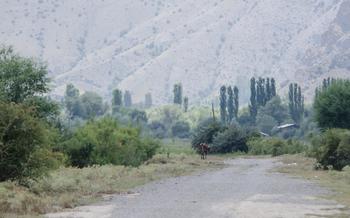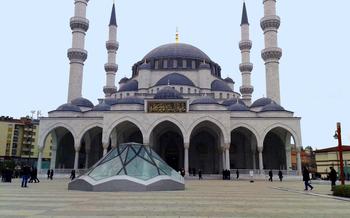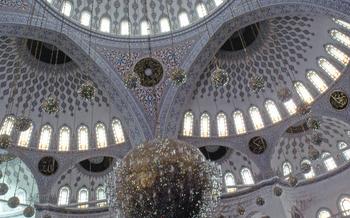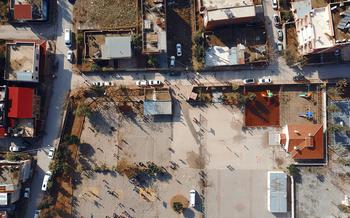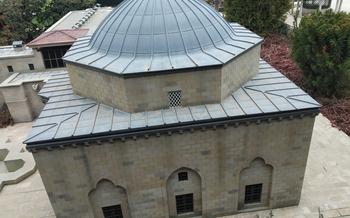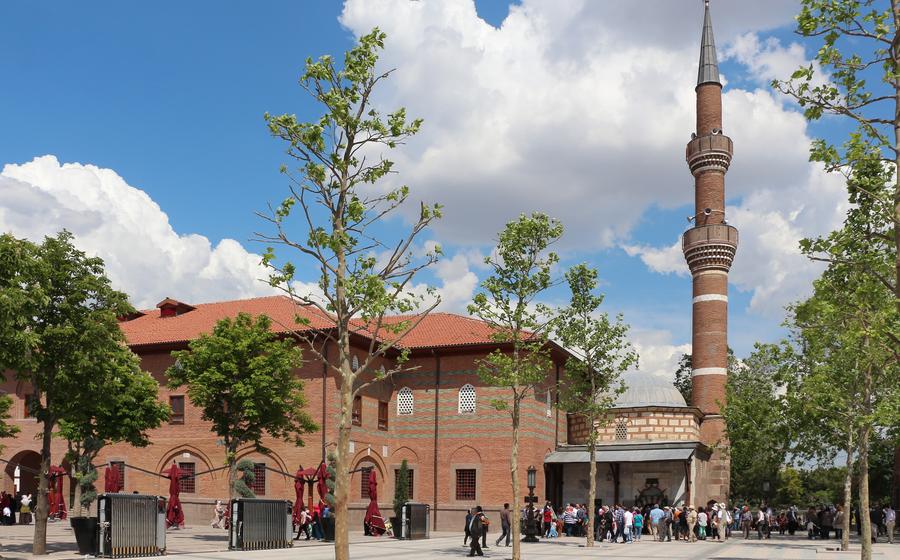
Hacı Bayram Mosque
- Historical Significance
- Spiritual Importance
- Architecture and Design: A Masterpiece of Islamic Art and History
- Prayer Hall
- Minaret
- Dome
- Calligraphy and Art
- Local Culture and Traditions
- Nearby Attractions:
- Photography Tips: Capturing the Essence of the Hacı Bayram Mosque
- Dress Code and Etiquette
- Insider Tip: Experience the Serene Courtyard and Gardens
Historical Significance
The Hacı Bayram Mosque, a captivating architectural marvel, stands as a testament to Ankara's rich history and cultural heritage. Founded in the 15th century by the renowned Sufi mystic Hacı Bayram Veli, this sacred space has played a pivotal role in shaping the city's religious and cultural landscape. As one of the oldest mosques in Ankara, it has witnessed the ebb and flow of history, serving as a beacon of faith and spirituality for generations of devout Muslims.
Its architectural style, a blend of Ottoman and Seljuk influences, reflects the diverse cultural heritage of the region. The mosque's striking features, including its intricate tilework, elegant arches, and soaring dome, showcase the exceptional craftsmanship of its builders. Over the centuries, the Hacı Bayram Mosque has undergone several renovations and expansions, each contributing to its unique character and historical significance.
One of the most captivating aspects of the mosque is its association with Hacı Bayram Veli, a revered Sufi master who played a crucial role in spreading Islamic teachings and promoting peace and harmony in the region. His legacy continues to inspire countless visitors who seek spiritual guidance and enlightenment within the mosque's hallowed walls.
Spiritual Importance
The Hacı Bayram Mosque holds immense spiritual significance for Muslims, serving as a sacred space for worship, contemplation, and connection with the divine. Its serene atmosphere and rich history create a sanctuary for those seeking spiritual solace and guidance. The mosque's intricate architecture and beautiful artwork inspire a sense of awe and reverence, enhancing the spiritual experience of visitors.
As a place of worship, the Hacı Bayram Mosque welcomes Muslims from all walks of life to come together and perform their daily prayers. The spacious prayer hall, adorned with intricate calligraphy and vibrant colors, provides a tranquil environment for worshippers to connect with their faith. The mihrab, a niche in the wall indicating the qibla (direction of prayer), acts as a focal point, guiding the faithful towards Mecca.
Beyond its role as a place of prayer, the Hacı Bayram Mosque also serves as a center for Islamic learning and education. Regular religious classes, workshops, and lectures are held within the mosque's premises, allowing visitors to deepen their understanding of Islam and its teachings. The mosque's knowledgeable imams and scholars are always ready to answer questions and provide guidance to those seeking spiritual enlightenment.
Whether you are a devout Muslim seeking a sacred space for worship or a curious traveler interested in exploring the spiritual side of Ankara, the Hacı Bayram Mosque is a must-visit destination. Its rich history, architectural beauty, and spiritual atmosphere create an unforgettable experience for all who step through its doors.
Architecture and Design: A Masterpiece of Islamic Art and History
The Hacı Bayram Mosque stands as a testament to the architectural prowess of the Ottoman Empire. Its design embodies the principles of classical Islamic architecture, blending harmoniously with the surrounding cityscape of Ankara. The mosque's exterior facade captivates with its intricate stone carvings, geometric patterns, and elegant calligraphy, reflecting the rich artistic traditions of the era.
The central dome, a defining feature of Islamic architecture, dominates the skyline, symbolizing the heavens and the connection between the earthly and the divine. Its graceful curves and intricate tilework create a sense of awe and wonder, drawing the gaze upward. The four slender minarets, each adorned with delicate balconies and topped with elegant finials, accentuate the verticality of the structure, reaching towards the sky like celestial beacons.
The spacious courtyard, surrounded by arched colonnades and lush gardens, provides a tranquil oasis amidst the bustling city. The rhythmic arrangement of columns and arches creates a serene ambiance, inviting visitors to pause and reflect. The courtyard also features a beautiful ablution fountain, adorned with intricate carvings and flowing water, symbolizing purification and preparation for prayer.
Inside the mosque, the prayer hall unfolds as a vast and awe-inspiring space. The mihrab, a niche indicating the direction of Mecca, is adorned with exquisite calligraphy and intricate tilework, drawing the faithful towards the sacred Kaaba. The minbar, or pulpit, stands as a symbol of authority and guidance, intricately carved with verses from the Quran. The elaborately decorated ceiling, supported by elegant columns, adds to the grandeur of the interior, creating a sense of reverence and spirituality.
Prayer Hall
The prayer hall of the Hacı Bayram Mosque is a sight to behold, its vast space adorned with intricate designs and Islamic calligraphy. The towering mihrab, the niche indicating the direction of Mecca, is adorned with colorful tiles and intricate carvings, drawing the eyes of worshippers as they align themselves in prayer. The minbar, or pulpit, stands tall, its elegant staircase leading to a platform where the imam delivers sermons, his words echoing through the hall, guiding the faithful in their spiritual journey. The prayer hall is a place of tranquility and devotion, where the faithful come together to seek solace and connect with the divine.
Minaret
The Hacı Bayram Mosque boasts a single, slender minaret that rises gracefully towards the sky, beckoning the faithful to prayer. Its towering presence serves as a symbol of faith and a beacon of hope for the surrounding community. The minaret's intricate design features intricate carvings and geometric patterns that showcase the artistry and craftsmanship of Islamic architecture. From its balcony, the muezzin's melodious call to prayer reverberates through the air five times a day, echoing through the streets of Ankara and inviting the city's inhabitants to come together in worship. The minaret stands as a testament to the enduring legacy of Islamic architecture and its ability to inspire and uplift the human spirit.
Dome
The imposing dome of the Hacı Bayram Mosque stands as a testament to the architectural prowess of the Ottoman era. Its graceful curves and intricate patterns are a sight to behold, creating a sense of awe and wonder. The dome's design embodies the principles of Islamic architecture, emphasizing symmetry and balance. Constructed using traditional methods, the dome showcases the skill and craftsmanship of the builders who created this architectural masterpiece.
The interior of the dome is adorned with intricate paintings and calligraphy, adding to its visual splendor. The dome's primary function is to amplify and distribute the sound of the call to prayer, ensuring that it reaches every corner of the mosque and beyond. Its harmonious acoustics create a spiritual ambiance that enhances the experience of worship and contemplation within the mosque.
Calligraphy and Art
The Hacı Bayram Mosque is renowned for its exquisite calligraphy and artwork, which adorn its walls, columns, and mihrab. These intricate designs and inscriptions are not merely decorative elements but hold deep religious and cultural significance. The calligraphy, often in elegant Arabic script, features verses from the Quran, the sayings of the Prophet Muhammad, and other sacred texts. The artwork, which includes intricate geometric patterns, floral motifs, and depictions of natural scenes, reflects the rich artistic traditions of Islamic culture.
The calligraphy in the Hacı Bayram Mosque is particularly notable for its beauty and precision. The skilled calligraphers who created these inscriptions used a variety of techniques, including gilding, embossing, and inlaying, to achieve stunning effects. The result is a harmonious blend of art and spirituality that elevates the mosque's atmosphere and inspires awe in visitors.
One of the most striking examples of calligraphy in the mosque is the inscription above the mihrab, which reads, "Allah is the light of the heavens and the earth." This verse, taken from the Quran, serves as a reminder of God's omnipresence and the divine guidance that illuminates the path of believers.
The artwork in the Hacı Bayram Mosque is equally impressive. The walls and ceilings are adorned with intricate geometric patterns, which create a sense of order and harmony. The floral motifs, often featuring stylized tulips and roses, add a touch of elegance and beauty to the mosque's interior.
The combination of calligraphy and artwork in the Hacı Bayram Mosque creates a visually stunning and spiritually uplifting environment. These artistic elements serve as a testament to the skill and devotion of the artisans who created them, and they continue to inspire and awe visitors to this day.
Local Culture and Traditions
The Hacı Bayram Mosque is deeply embedded in the local culture and traditions of Ankara. It serves as a spiritual and cultural hub for the community, hosting various religious ceremonies, festivals, and gatherings throughout the year. The mosque's courtyard often transforms into a lively space where people come together to socialize, share meals, and celebrate special occasions. Locals take pride in the mosque's rich history and consider it a symbol of their heritage. Visitors can witness the mosque's significant role in the community by observing the daily rituals and practices of the local people. From attending Friday prayers to participating in religious classes and workshops, the mosque fosters a sense of unity and belonging among the residents of Ankara.
Nearby Attractions:
After exploring the Hacı Bayram Mosque, visitors can immerse themselves in the rich cultural heritage of Ankara by visiting nearby attractions that offer a glimpse into the city's past and present. A short walk from the mosque leads to the Ankara Castle, a majestic fortress that stands as a testament to the city's ancient origins. Within the castle walls, visitors can explore the Museum of Anatolian Civilizations, which houses an impressive collection of artifacts from various civilizations that have flourished in the region.
For those seeking a more modern experience, the Çengelhan Rahmi M. Koç Museum, located just a few minutes away from the mosque, offers a fascinating journey through the history of transportation and industry. The museum's collection includes vintage cars, motorcycles, airplanes, and other machinery, providing a glimpse into Ankara's transformation into a modern metropolis.
Art enthusiasts can indulge in the vibrant contemporary art scene at the Cer Modern, a renowned art gallery that showcases works by both established and emerging Turkish and international artists. The gallery's exhibitions offer a unique perspective on the dynamic art scene of Ankara and provide a platform for artistic expression and dialogue.
To experience the bustling energy of Ankara, visitors can head to the Kızılay district, a vibrant commercial hub known for its shopping malls, restaurants, and lively atmosphere. The district offers a diverse array of culinary delights, from traditional Turkish cuisine to international flavors, catering to every palate.
Photography Tips: Capturing the Essence of the Hacı Bayram Mosque
The Hacı Bayram Mosque offers a plethora of stunning photo opportunities, allowing visitors to capture the essence of its architectural grandeur and spiritual atmosphere. For those who wish to immortalize their visit through the lens of a camera, here are a few tips to help you create beautiful and memorable photographs:
-
Golden Hour Magic: Plan your visit during the golden hours, just after sunrise or before sunset, when the mosque's facade glows with a warm, golden light. This soft, diffused light enhances the intricate details of the architecture and creates a captivating ambiance.
-
Symmetry and Perspective: Utilize the mosque's symmetrical design to create visually appealing compositions. Experiment with different angles and perspectives to capture the mosque's full grandeur. Try shooting from a low angle to emphasize its towering minarets or from a high vantage point to capture the mosque's intricate dome against the Ankara skyline.
-
Interior Details: Don't limit yourself to exterior shots. Step inside the mosque and capture the intricate details of the prayer hall, such as the ornate mihrab, the delicate calligraphy adorning the walls, and the beautiful stained-glass windows.
-
People and Atmosphere: Include people in your photographs to add a sense of scale and convey the mosque's vibrant atmosphere. Capture worshippers engaged in prayer, visitors exploring the courtyard, or locals going about their daily lives. These elements will add a touch of authenticity and life to your images.
-
Respectful Photography: Always be mindful of the sacred nature of the mosque and respect the privacy of worshippers. Avoid using flash photography or disturbing ongoing religious activities. Ask for permission before photographing people, and be prepared to politely decline if they object.
Dress Code and Etiquette
When visiting the Hacı Bayram Mosque, it is essential to dress modestly and respectfully. This means avoiding clothing that is too revealing or tight-fitting. For men, long pants and a collared shirt are appropriate attire. Women should wear a headscarf to cover their hair and a long, loose-fitting dress or skirt. It is also important to remove your shoes before entering the prayer hall.
Visitors should also be mindful of their behavior while in the mosque. This means speaking quietly, avoiding taking photos during prayer times, and not disturbing worshippers. It is also important to remember that the mosque is a sacred place for Muslims, and visitors should behave accordingly.
Respecting local customs and traditions is essential when visiting the Hacı Bayram Mosque. By following the dress code and etiquette guidelines, visitors can show their respect for the mosque and the Muslim community.
Insider Tip: Experience the Serene Courtyard and Gardens
Unveil the hidden oasis within the Hacı Bayram Mosque by venturing into its tranquil courtyard and gardens. Amidst the bustling city, this serene haven offers a sanctuary for contemplation and spiritual reflection. As you step into the courtyard, let the soothing sound of water fountains and the gentle rustling of leaves envelop you. Immerse yourself in the vibrant tapestry of colors as flowers bloom in profusion, adding a touch of beauty to the sacred space. Find a secluded spot beneath the shade of ancient trees, where you can sit in silence and absorb the tranquility of the surroundings. Let the worries of the world melt away as you connect with your inner self and find peace amidst the serenity of the mosque's courtyard and gardens.

